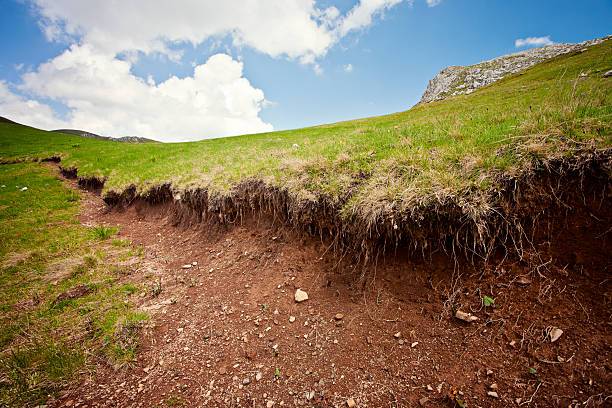
According to a new study published in the journal Earth's Future by the University of Massachusetts Amherst, agricultural fields in the midwestern United States have lost an average of two millimetres of soil per year since Euro-American settlement about 160 years ago.
Rate of Soil Erosion Doubled
The USDA considers this to be nearly twice the rate of erosion that is considered sustainable. In addition, USDA erosion estimates are three to eight times lower than the figures reported in the study. Finally, the authors of the study conclude that ploughing, rather than wind and water, is the primary cause.
"My wife and I were at a wedding at a pioneer Norwegian church in Minnesota a few years ago," says Isaac Larsen, professor of geosciences at UMass Amherst and one of the paper's co-authors. "Following the ceremony, I walked over to the edge of the churchyard, which was surrounded by cornfields, and was astounded to discover that the surface of the field was a few feet lower than the surface of the never-tilled churchyard. I started to wonder why."
After a few years, Larsen, along with the paper's co-lead authors, Evan Thaler, who completed the research as part of his Ph.D. at UMass Amherst, and Jeffery Kwang, a postdoctoral researcher at UMass Amherst at the time of the study, found himself in central Iowa on the "escarpment," or drop-off, separating a native prairie from a field of soybeans.
Thaler had spent a significant amount of time working with the Iowa Natural Heritage Foundation and other organisations to identify the few remaining pockets of original, never-farmed prairie. He then approached the farmers whose land bordered the prairies, requesting permission to survey their fields.
Thaler ended up with twenty locations, the vast majority of which were in central Iowa, with a few in Illinois, Minnesota, South Dakota, Kansas, and Nebraska. "I drove around the Midwest for days knocking on doors," Thaler explained. "Before allowing you to enter their property, people want to see your face and have a conversation with you. When I arrived in person, no one turned me away."
The team got to work as soon as Thaler got permission from the landowner. The team walked dozens of transects, or perpendicular routes across the escarpment, from the untouched prairie to the eroded farm field, stopping every few inches to measure the change in altitude with an extremely sensitive GPS unit that looks more like a floor lamp than a handheld device. They repeated this hundreds of times over the summers of 2017, 2018, and 2019.
The team used historical land-use records and cutting-edge computer models to reconstruct erosion rates across the Midwest once they had their raw data. They discovered that topsoil in the Midwest is eroding at a rate of 1.9 millimetres per year on average.
In other words, the authors estimate that the Midwest has lost about 57.6 trillion metric tonnes of topsoil since farmers began tilling the soil 160 years ago. This is despite the fact that conservation practices were implemented in the aftermath of the Dust Bowl in the 1930s.
It's also obvious that much of the erosion is caused by tillage or ploughing. "My modelling shows that tilling has a 'diffusive' effect," Kwang says. "It melts away the landscape, flattening higher points in a field and filling in hollows." According to Thaler, the USDA has "dramatically underestimated the rate of erosion" currently at work in the heartland because it does not explicitly include such "tillage erosion" in its own analysis.
"As our soils deteriorate, so does our ability to grow food," Larsen says. "When you combine this with rising global population and climate stress, we have a serious problem." The researchers believe that more sustainable practises, such as no-till farming and soil regeneration, will be needed to "reduce soil erosion rates in the Midwest to levels that can sustain soil productivity, ecosystem services, and long-term prosperity."
(Source: University of Massachusetts Amherst)
















